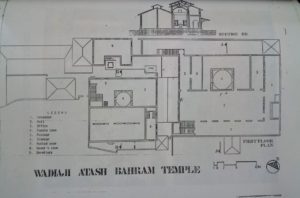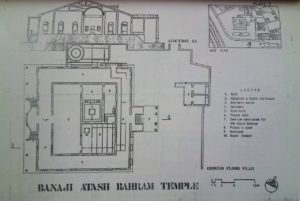—–By Heritage Architect Sanaeya Vandrewala
Fire Temple —Aatash Bahram, Agiaries & Dadgahs
“O Ahura, Thy Divine Fire

A DEPICTION.
Grown mighty through Asha, do we earnestly desire!
Swiftest of the swift, supremely powerful,
Giving clear help, at all times, to the faithful.
But Mazda, Thy fire shall see through and annihilate,
With a turn of the hand, the evil and their hate.”
[Gatha Ahunavaiti, Yasna 34.4]Fire in Zoroastrianism is the center for worship. It is a Zoroastrian belief that through veneration of fire one can create an intimate communion with God, who is the creator of this sacred fire. It is the third holy immortal and has a religious significance of being a symbol of righteousness. Prophet Zarathushtra mentions fire as the holiest of the elements to be worshiped as the source of heat, light, life and growth. He selected it as a symbol of his faith to symbolize the divine spark within. Fire, in Zoroastrianism therefore, is considered one of the most sacred elements of nature.
In ancient times, Zoroastrians had no fixed place of worship. It was in Achaemenian times, during the reign of Darius I (522-486 BC) that permanent altars were built as a place for worship. The earliest places of worship were probably sanctuaries founded by kings and nobles dedicated to Bahrām the Yazata for victory. Fire altars on stone platforms were built during Achaemenian (550 BC- 330 BC) and Sassanian times (224 AD -652 AD) and depicted in inscriptions, carvings and coins. Congregational ceremonies took place under an open sky, where the worshipers gathered. The most sacred fires were placed in secluded areas.

The western world has wrongly interpreted Zoroastrianism to be a fire-worshiping cult. The concept of the element of nature was confused, by the general population, with that of the spirit that resides within it. Fire occupies an important place amongst the elements in the religious system of Zoroastrianism. Such veneration should not be misunderstood as deity worship, as the religion is monotheistic in its belief and similar homage is paid to the other elements of nature.
There are three grades of consecrated fire in India, based on the level of the consecration of the fire enthroned in the sanctum sanctorum.


1. Aatash Bahrām (Top-most grade of Fire-Temple) :
An Aatash Bahrām is the highest grade of fire with the highest level of consecration. It is consecrated through elaborate purification ceremonies performed by Mobeds (priests). Fire from sixteen different sources are collected, purified and used after 14,000 hours of prayer ceremonies. This fire is then enthroned in the sanctum sanctorum of the Aatash Bahrām. The entire process is well spanned over a period of 18 months. Hence the Aatash Bahrām fire is no ordinary fire, but the one kindled into existence through the performance of extraordinary series of complex rituals.
| Sr.no | Kinds of fire | No of times for the basic collection, purification and consecration process |
| 1 | Fire of a burning corpse | 91 |
| 2 | Fire of a dyer | 80 |
| 3 | Fire of a king or ruling authority | 70 |
| 4 | Fire of a potter | 61 |
| 5 | Fire of a brick maker | 75 |
| 6 | Fire of an ascetic | 50 |
| 7 | Fire of a goldsmith or alchemist | 60 |
| 8 | Fire of a mint | 55 |
| 9 | Fire of an ironsmith | 61 |
| 10 | Fire of a maker of armors | 61 |
| 11 | Fire of a baker | 61 |
| 12 | Fire of a brewer | 61 |
| 13 | Fire of a soldier or traveler | 35 |
| 14 | Fire of a shepherd | 33 |
| 15 | Fire atmospheric electricity(lightning) | 90 |
| 16 | Fire of a Zoroastrian (a fire kindled through friction by a Dastur and Mobed one each and these are then mixed with a Behdin (non priest) | 184 |
| 1128 times |
Above Table Source: Dr. Sir J.J Modi, The religious ceremonies and customs of Parsees
The existing Aatash Bahrams in India:
- Iranshah established in Sanjan in 855 AD and then finally moved to Udvada in 1742 AD, where it has stood since then;
- Anjuman Atash Bahram in Navsari (1765 AD )
- Dadyseth Atash Bahram in Mumbai (1783 AD )
- Modi Atash Bahram in Surat (1823 AD)
- Vakil Atash Bahram in Surat (1823 AD)
- Wadia Atash Bahram in Mumbai (1830 AD)
- Banaji Atash Bahram in Mumbai (1845 AD)
- Anjuman Atash Bahram in Mumbai (1897 AD)
- Atash Adaran (The next grade of Fire-Temple):
The fire in an Atash Adaran is consecrated with fewer rituals and is peculiar to the Parsi Zoroastrians. Such fires are installed in Agiaries (Sanskrit for ‘House of Fire’). This fire must be kept perpetually burning and is therefore tended by a priest at Boi ceremonies five times a day. There are hundreds of such Adarans in India with the maximum number in Mumbai. The oldest is in Navsari, installed in 1150 AD. There are no Atash Adaran fires anywhere else in the world.
- Atash Dadgah (the third grade of Fire -Temple):
This is the third grade of fire. Its consecration is simpler as compared to the first two. This fire temple is often called a Dar-e-Meher. The Atash-e-Dadgah can be touched by both a priest and a layman but not a non-Zoroastrian.
The Architecture of Fire temples in India
Between the 18th and 19th centuries, seven Atash Bahrams and hundreds of Adarans and Dadgahs were built in India reflecting the prosperity of the Zoroastrian populace. All temples are based on the triadic principle. Hence the entry from an outer portico would have a corridor adjacent which is used for basic rituals and kusti prayers before entering the assembly hall and inner prayer hall. The passage adjacent to the portico acts as transitional space between the outside and the prayer hall to preserve the sanctity of hall.

The inner chamber, where the sacred fire is installed, is a square room surrounded on three sides by the prayer hall. The southern side is a dead wall, to ensure the devotees do not face the north during prayers. This is done based on the religious belief that the ‘evil’ resides in the north, hence the architectural proscription. Niches are built into the walls for ritual purity. The other three sides of the inner chamber have openings to facilitate the view of the sacred fire during prayer ceremonies, once, inside the fire temple, the prescribed Zoroastrian mandate to face east when praying is prescribed; one must face the consecrated fire when praying. The inner chamber or sanctum sanctorum has only one door for entry and exit.

The floor is generally covered with hard basalt stone, demarcated by three sets of furrows, known as ‘Pavis’ in Gujarati. The sacred fire is placed within the innermost area marked by furrows. Generally, the sanctuary is domed, with flues cut into it to facilitate the exit of smoke generated by the fire. In most of the cases the dome is a false ceiling to the pitched roof that is supported by the masonry.
Every fire temple must have within its complex, an open well that is fed by freshwater springs and should include a pomegranate tree and a date tree. The leaves of these trees are used during rituals performed during various religious ceremonies. The fire temple complex also has a place of residence for priests who serve the fire (‘Boiwalas’).
With the decline in population, the question of the continued use and maintenance of these places of worship has arisen. With no population to tend to or serve in certain areas, the community is faced with the challenge of the future existence of these structures.
References:
Godrej, P and Mistree, P (Ed) (2002) A Zoroastrian Tapestry: Art, Religion and Culture. Ahemdabad: Mapping publishing Pvt Ltd.
Masani (2001, 86) Masani,R (2001)The religion of the good life Zoroastrianism. London: George Allen and Unwin Ltd.
Mistree,K (1982) Zoroastrianism : An ethnic perspective. Bombay: Khojeste P. Mistree
Motafram, R (1984) Zoroastrianism Vol III: Light on Zoroastrianism. Mumbai: The trustees of the Parsi Punchayat funds and properties, Bombay.
Rivetna,R (Ed) (2002) The legacy of Zarathrushtra:An introduction to religion , history and culture of the Zoroastrians. Illinois: Federation of Zoroastrian association of North America
]]>

Indian Foreign Policy–an overview by Aparna Pande, Director of the Initiative on the Future of India and South Asia, at Hudson Institute, Washington D.C.
Want to dispel the opinions and views formed on rumours and personal tales about the way India deals with its neighbours and the world? Read the evolution of the India’s Foreign Policy in the book ‘FROM CHANAKYA TO MODI’, by Aparna Pande. and student from Stephen’s College, University of Delhi, JNU and Boston University,
India’s foreign policy like that of “Every country’s foreign policy, has an underlying paradigm that explains what has influenced its policy and why that country takes its own unique stand. This paradigm is the product of the nation’s history and its view of self. Leaders, especially those in premier positions for long periods, also shape how a nation sees itself in relation to others”, says Aparna
Aparna Pande’s new book, launched last week at a function at the Observer Research Foundation on August 5, ,traces the evolution of India’s Foreign Policy all the way ‘From Chanakya to Modi’ today.
It is a book that Aparna has dreamt of writing for a long, long time and a book that we as individual citizens of India have wanted to read for an equally long time: factual, intelligent, and objective elucidation of India’s position on the globe and in the Global Political World; the events, circumstances and people that caused this position and policy—India’s Foreign Policy.
A book that explains India’s foreign policy to the world and to its people: what are the ideas that have influenced foreign policy, the individuals who have left their mark and the institutions that play and played a role in shaping the policy?
 …And who better than the learned to give us an overview of the Indian foreign policy as shaped from ancient times to the present millennia. Aparna has examined both sides of the border. She had earlier written a treatise on” Explaining Pakistan’s Foreign Policy: Escaping India” (Routledge, 2011), a policy much discussed by every Indian, all the time. She is also the editor of Contemporary Handbook on Pakistan (Routledge, 2016).
…And who better than the learned to give us an overview of the Indian foreign policy as shaped from ancient times to the present millennia. Aparna has examined both sides of the border. She had earlier written a treatise on” Explaining Pakistan’s Foreign Policy: Escaping India” (Routledge, 2011), a policy much discussed by every Indian, all the time. She is also the editor of Contemporary Handbook on Pakistan (Routledge, 2016).
At book launch last week Aparna was impressive; succinct, clear, confident and knowledgeable. Her short but to the point speech left the audience panting for more; surprised at its brevity, richness and precision.
As the name suggests, Aparna’s book starts with the legacy of Chanakya and the ancient philosophers on the India’s Foreign Policy, moving on, to the medieval era of the sultans, through to the much reviled British colonial strategists of the Raj and finally the Indian National Movement for an independent India. According to Aparna, these legacies are still perceptively evident on India’s external relations.
The book lays out four major strands in the contemporary India’s Foreign Policy: Imperialist legacy, Messianic Idealism, Realism and Isolationism.
The ‘Imperial’ school of thought draws primarily from period of the British Raj. For this outlook, India Policy is the central policy and Delhi knows best. India’s post-independence policy towards its immediate South Asian neighbours best exemplifies this idea. Delhi, whether under the British or thereafter, has always believed that India’s central government is best suited to make security decisions.
‘Messianic Idealism,’ reflecting the mantra of global peace, justice and prosperity has served as the strong moral component of India’s foreign policy, inspired by the moral legacy of ancient Indian thought reiterated during national struggle under Mahatma Gandhi. Proponents of this perspective believe that India is an example for the world to emulate and that India has a duty to set such an example.
India has had no qualms in anchoring external relations in ‘Realism’. Belief in moral principles did not turn Indian leaders into pacifists. Notwithstanding the idealism, New Delhi has always recognized the importance of hard power for the success of the State.
Then there is the contradiction of ‘Isolationism’. India has been obvious in its reluctance to be drawn into global issues or ideologies and yet, has always chooses to play a global role. There is this strong streak of ‘isolationism’ in India’s global outlook. It is one of India’s many paradoxes that it wants to be seen as a great power and is still often reluctant to do what is required of most great powers.
Aparna analyzes the what and the why of the foreign policies followed by all the Prime Ministers of independent India – from Jawaharlal Nehru to Narendra Modi; The rationale and raison d’être for each Prime Minister’s policy. Interestingly, Aparna finds that while each Premier tried to walk his own path, there is a remarkable degree of continuity in the policies followed over the independent decades of different governments.
Individuals aside, Aparna details the role of an array of institutions that played a role in formulating and shaping India’s foreign policy— the primacy of the prime minister’s office, the role of ministry of external affairs, parliamentary oversight, the responsibility of the national Security Council, the role played by the media and new actors.
This book by Aparna Pande makes interesting and informative reading for the lay and the cognizant; dispelling rumour and myth that rules the Indian polity and lay opinion.
]]>